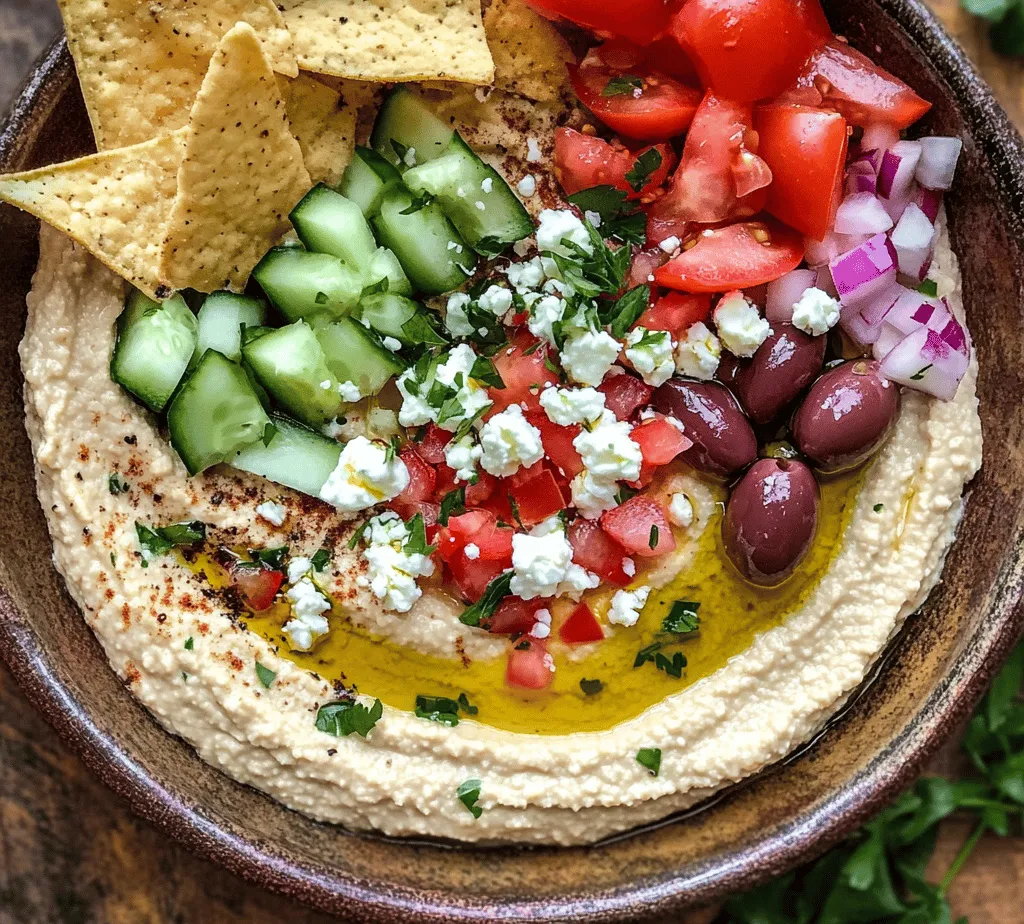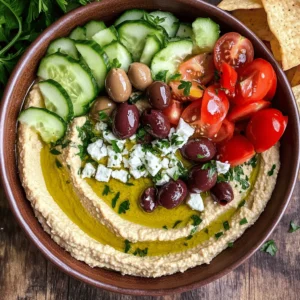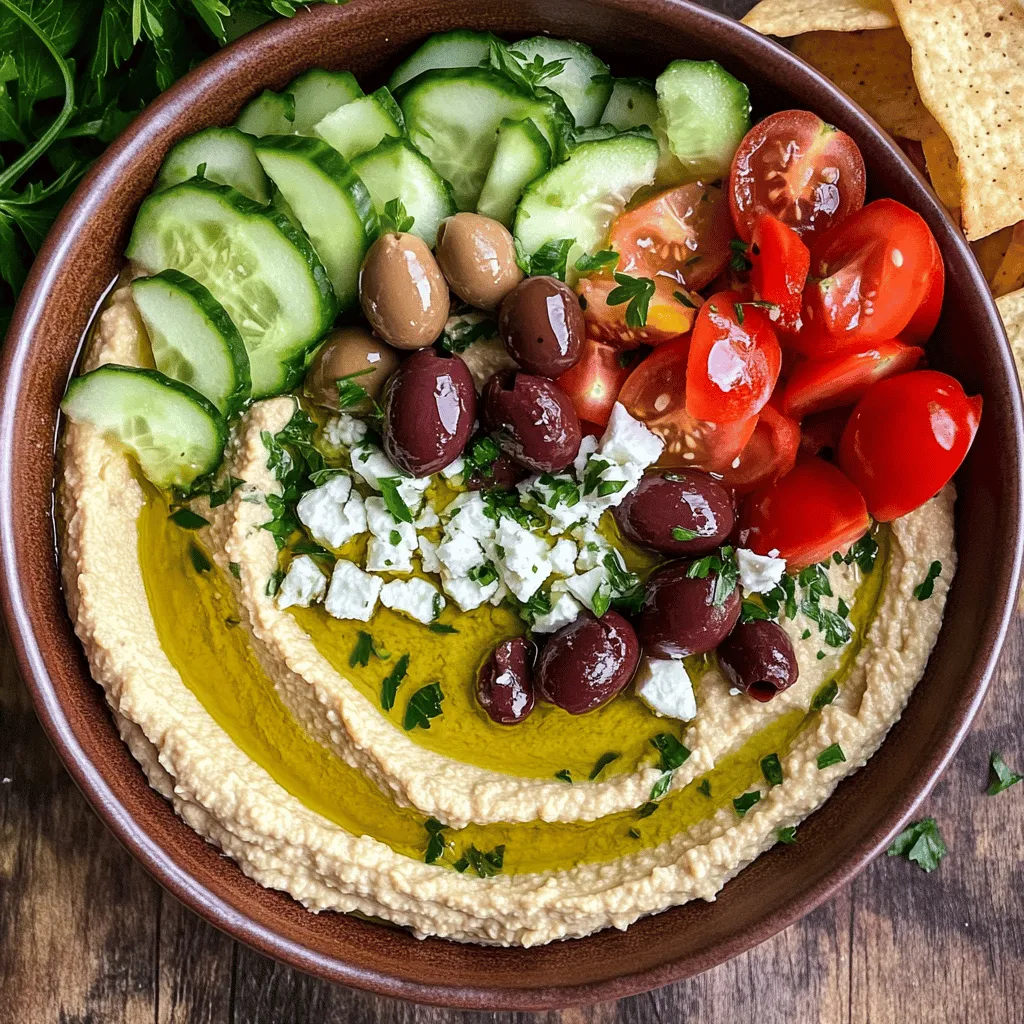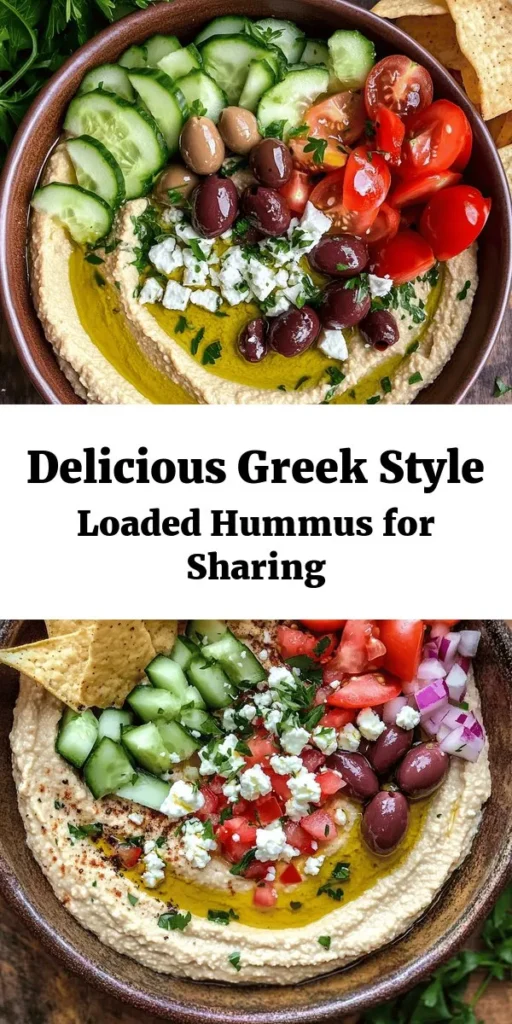Delve into the delightful world of Greek cuisine with our Greek Style Loaded Hummus recipe. This dish not only offers a creamy and flavorful dip but also embodies the essence of Mediterranean ingredients that celebrate health and taste. Perfect for gatherings, snacks, or a simple meal, this hummus elevates traditional recipes with fresh vegetables, tangy feta, and savory olives. In this article, we will explore the origins of hummus, its nutritional benefits, and an in-depth look at the ingredients and preparation process.
Understanding Hummus: A Brief History
Exploring the Origins of Hummus
Hummus has a rich and fascinating history that spans centuries and regions. While its exact origins remain a topic of debate among food historians, it is widely believed to have roots in the Middle East. Countries such as Lebanon, Israel, and Palestine each lay claim to the creation of this beloved dip, which highlights the shared culinary heritage of the region.
The word “hummus” itself is derived from the Arabic word for chickpeas, “hummus al-tahini,” which literally means “chickpeas with tahini.” The earliest recipes for hummus can be traced back to the 13th century, where references to chickpea-based dips were found in cookbooks from the Levant. As trade and cultural exchanges flourished in the Mediterranean, hummus transformed and evolved, adapting to local tastes and available ingredients.
Hummus has become a staple in Mediterranean diets, celebrated not only for its rich flavors but also for its versatility. It can be enjoyed as a dip, spread, or even a component in various dishes. The beauty of hummus lies in its adaptability; different regions have their own unique variations, incorporating local herbs, spices, and additional ingredients to create a diverse array of flavors. For instance, in Turkey, you might find hummus spiced with cumin and served with a drizzle of olive oil, while in Greece, it’s common to include toppings like feta cheese and olives.
The Significance of Hummus in Mediterranean Diets
Hummus holds a significant place in Mediterranean diets, often regarded as a healthy and nutritious option. The Mediterranean diet is characterized by an abundance of plant-based foods, healthy fats, and lean protein sources, all of which are components of traditional hummus. The inclusion of chickpeas, tahini, and olive oil provides essential nutrients, making hummus a popular choice for individuals seeking healthier eating options.
The Mediterranean diet has been linked to numerous health benefits, including reduced risks of heart disease, improved brain function, and increased longevity. Incorporating hummus into this diet not only adds flavor but also contributes to the overall nutritional profile. The balance of carbohydrates, proteins, and healthy fats in hummus makes it a satisfying snack or meal component, allowing for a diverse array of pairings with vegetables, pita bread, or as a spread on sandwiches.
Variations of Hummus in Different Regions
As hummus traveled across borders, it adapted to various culinary traditions, resulting in an assortment of regional variations. In the Levant, you may find hummus topped with spiced ground meat and pine nuts, while in North Africa, it might be blended with harissa for a spicy kick. Each locale has its own distinct twist, showcasing the ingredients and flavors that are locally cherished.
In addition to its regional variations, the modern culinary scene has seen a surge in creative takes on hummus. From roasted red pepper and beet hummus to avocado and black bean versions, the possibilities are virtually limitless. This recipe for Greek Style Loaded Hummus takes inspiration from traditional Greek flavors, infusing the classic dip with fresh vegetables, feta cheese, and olives to create a vibrant and satisfying dish that is sure to impress.
Nutritional Benefits of Hummus
Highlighting the Health Aspects
Hummus is not only delicious; it’s also packed with nutritional benefits that make it an excellent addition to your diet. Below are some of the key health aspects of this creamy dip:
1. Rich in Plant-Based Protein and Fiber: Chickpeas, the main ingredient in hummus, are an excellent source of plant-based protein. A single serving of hummus can provide a substantial amount of protein, making it especially beneficial for vegetarians and vegans. Additionally, the fiber content in chickpeas supports digestive health and helps keep you feeling full longer.
2. Healthy Fats from Tahini and Olive Oil: The inclusion of tahini, made from ground sesame seeds, adds healthy fats to hummus. These fats are essential for maintaining heart health and supporting overall well-being. Extra-virgin olive oil, a staple in Mediterranean cuisine, also contributes healthy monounsaturated fats, which can help lower cholesterol levels and reduce the risk of heart disease.
3. Antioxidants and Vitamins from Fresh Vegetables: When you load your hummus with fresh vegetables, such as cucumbers, tomatoes, and bell peppers, you introduce a wealth of vitamins, minerals, and antioxidants. These nutrients play a crucial role in supporting immune function, reducing inflammation, and promoting overall health.
4. The Role of Hummus in a Balanced Diet: Incorporating hummus into your meals and snacks not only enhances flavor but also provides a nutritious option that complements a balanced diet. Whether you’re enjoying it with whole grain pita, as a spread on sandwiches, or as a component in salads, hummus can fit seamlessly into various dietary preferences.
Ingredients Breakdown for Greek Style Loaded Hummus
Overview of Essential Ingredients
Now that we’ve explored the history and nutritional benefits of hummus, let’s dive into the essential ingredients that make our Greek Style Loaded Hummus both delicious and nutritious.
1. Chickpeas: The foundation of hummus, chickpeas are high in protein and fiber. When using canned chickpeas, remember to rinse them thoroughly to remove excess sodium.
2. Tahini: This creamy paste made from sesame seeds is crucial for achieving the smooth texture of hummus. It adds depth and richness to the flavor profile.
3. Fresh Lemon Juice: The bright acidity of lemon juice balances the creaminess of tahini and provides a fresh, zesty flavor. It also enhances the overall taste of the hummus.
4. Garlic: Infusing hummus with minced garlic adds a pungent flavor and numerous health benefits, including anti-inflammatory properties and immune system support.
5. Extra-Virgin Olive Oil: A key ingredient in Mediterranean cuisine, high-quality olive oil not only adds flavor but also contributes healthy fats essential for a balanced diet.
6. Seasonings: Cumin and smoked paprika are essential for adding depth and warmth to the hummus. These spices enhance the overall flavor and create a unique twist on the traditional recipe.
Exploring the Toppings
What sets Greek Style Loaded Hummus apart is the vibrant assortment of toppings that elevate the dish. Here are some popular toppings to consider:
– Feta Cheese: Crumbled feta adds a tangy and creamy element that pairs beautifully with the hummus base.
– Kalamata Olives: These briny olives bring a rich flavor that complements the creaminess of the hummus.
– Sliced Cucumbers and Cherry Tomatoes: Fresh vegetables add a refreshing crunch and balance the richness of the dip.
– Fresh Herbs: Chopped parsley or dill can brighten the dish and add an aromatic touch.
As we proceed with the recipe, you’ll see how easy it is to create a stunning Greek Style Loaded Hummus that not only looks beautiful but tastes incredible. With fresh ingredients and simple preparation steps, you’ll be ready to impress your friends and family with this Mediterranean delight. Stay tuned for the detailed instructions and tips to perfect your hummus-making skills!

Diced Cucumber: Freshness and Crunch
To elevate your Greek Style Loaded Hummus, adding diced cucumber introduces a refreshing crunch that balances the richness of the hummus. Cucumbers are not only crisp and hydrating but also bring a subtle flavor that complements the other ingredients. Aim for small, uniform dice to ensure they mix well and provide a pleasant texture with each bite.
Diced Tomatoes: Color and Juiciness
Next, incorporate diced tomatoes into your creation. Their bright color adds visual appeal, while the juicy flesh contributes a burst of freshness. Choose ripe, flavorful tomatoes for the best results. Like the cucumbers, ensure they are diced evenly for a consistent experience throughout the dish. The tomatoes will enhance the overall taste profile, making each mouthful a delightful medley of flavors.
Kalamata Olives: A Briny Touch of Flavor
Kalamata olives are a quintessential ingredient in Greek cuisine, and their inclusion in your hummus adds a briny, slightly bitter note that pairs beautifully with the creamy base. Slice the olives in half to release their flavor and integrate them seamlessly into the hummus. Their rich, deep flavor will contrast nicely with the freshness of the cucumbers and tomatoes, providing depth and complexity.
Feta Cheese: Creamy and Tangy Accent
No Greek dish is complete without feta cheese. Crumbled feta adds a creamy, tangy accent that enhances the overall flavor of the hummus. It serves as both a garnish and an integral component of the dish. Sprinkle crumbled feta generously on top of your hummus for a salty bite that contrasts with the other fresh ingredients. This ingredient not only contributes flavor but also texture, enriching your loaded hummus experience.
Fresh Parsley: A Pop of Color and Herbal Notes
Finally, finish your Greek Style Loaded Hummus with a sprinkle of fresh parsley. This herb not only adds a vibrant green hue but also infuses the dish with a hint of earthiness and freshness. Chop the parsley finely and sprinkle it over the top just before serving. This final touch brightens the whole dish, enhancing its appeal and flavor.
Step-by-Step Preparation of Greek Style Loaded Hummus
Detailed Instructions for Making Hummus
Preparing the Base: Blending Key Ingredients
To begin crafting your Greek Style Loaded Hummus, start by preparing the base. In a food processor, combine the key ingredients: drained canned chickpeas, tahini, fresh lemon juice, garlic cloves, and a drizzle of olive oil. Season with salt and a pinch of cumin for added depth. Blend the mixture until it reaches a smooth consistency, scraping down the sides as needed to ensure everything is well incorporated. The goal is to create a creamy, velvety base that serves as the foundation for your toppings.
Adjusting Consistency: Tips for Achieving the Perfect Texture
An essential step in hummus preparation is adjusting the consistency to suit your preference. If the hummus appears too thick, gradually add cold water or more olive oil, blending between additions until you achieve a creamy texture that is easy to scoop but still holds its shape. The ideal hummus should be smooth and spreadable, with a lightness that encourages pairing with various accompaniments.
Flavor Adjustments: Importance of Seasoning to Taste
Once you have blended the base, it’s crucial to taste and adjust the seasoning. This is where personalization comes into play. Depending on your palate, you may wish to add more salt, a splash of lemon juice for brightness, or additional garlic for a punchier flavor. Remember that the toppings will add their own flavors, so find a balance that suits your taste preferences while ensuring the base remains the star of the show.
Presentation: Creating an Appealing Serving Style
Presentation is key when serving Greek Style Loaded Hummus. Transfer the hummus to a large serving bowl and use the back of a spoon to create a shallow well in the center. Drizzle some high-quality olive oil into the well and arrange your toppings — diced cucumbers, tomatoes, Kalamata olives, crumbled feta, and chopped parsley — artfully around the hummus. This not only enhances the visual appeal but also invites guests to dive in and enjoy the vibrant flavors.
Serving Suggestions and Pairings
Ideal Accompaniments for Hummus
While the Greek Style Loaded Hummus is a star in its own right, the right accompaniments can elevate the dining experience. Here are some popular options to consider:
Pita Chips: The Classic Choice
Pita chips are a classic pairing with hummus, providing a crunchy texture that contrasts beautifully with the creamy dip. You can either buy them pre-made or make your own by cutting pita bread into wedges, brushing them with olive oil, and baking until crispy. The mild flavor of the pita won’t overpower the hummus, allowing the Mediterranean flavors to shine through.
Fresh Vegetables: A Healthy, Crunchy Alternative
For a healthier option, fresh vegetables are an excellent accompaniment. Carrot sticks, bell pepper strips, celery, and cucumber slices offer a satisfying crunch and a burst of freshness. They are not only nutritious but also provide a vibrant color contrast when served alongside the hummus. This combination is perfect for gatherings, as it caters to various dietary preferences and adds a healthy touch to your appetizer spread.
Other Mediterranean Dishes That Complement Hummus
Consider pairing your Greek Style Loaded Hummus with other Mediterranean dishes for a cohesive meal. Stuffed grape leaves (dolmas), tzatziki sauce with pita, or a simple Greek salad can enhance the flavors and create a satisfying spread. Each dish contributes to the overall theme of the meal, inviting guests to indulge in the rich tapestry of Mediterranean cuisine.
Cultural Significance of Hummus in Greek Cuisine
The Role of Hummus in Greek Meals
In Greek gastronomy, hummus is a staple that transcends mere appetizer status; it plays a vital role in various meals. Traditionally served as part of a meze platter, hummus accompanies a selection of small dishes, encouraging sharing and communal dining. This reflects a broader cultural value of togetherness in Greek society, where food is often enjoyed in the company of family and friends.
Hummus as a Social and Communal Dish
The act of gathering around a bowl of hummus connects people, fostering conversation and camaraderie. In Greek culture, meals are not just about nourishment; they are opportunities for bonding and storytelling. Hummus, with its inviting nature and versatility, is perfect for such occasions, inviting everyone to partake and enjoy together. This communal aspect enhances the dining experience, making it more than just a meal but a cherished tradition.
Celebrating Mediterranean Eating Patterns
Hummus also exemplifies the Mediterranean diet, which emphasizes fresh ingredients, healthy fats, and a variety of flavors. It is a fantastic representation of the diet’s principles, offering a nutritious option that is rich in fiber and plant-based protein. Embracing hummus in your meals aligns with healthy eating patterns that prioritize whole foods and balanced nutrition, making it a deserving addition to any modern kitchen.
Conclusion: Enjoying Greek Style Loaded Hummus
Greek Style Loaded Hummus is more than just a dip; it is a celebration of flavors, textures, and cultural traditions. This recipe invites you to explore the vibrant tastes of the Mediterranean, all while encouraging a healthy lifestyle through its wholesome ingredients. Whether you serve it at a gathering or enjoy it as a snack, this hummus offers a delightful experience that connects us to the communal spirit of Greek dining.
With its colorful toppings and creamy base, Greek Style Loaded Hummus is versatile enough for any occasion, from casual get-togethers to elegant dinner parties. The joy of sharing this dish lies not only in its delicious taste but also in its ability to bring people together. So, gather your loved ones, prepare this delectable hummus, and relish the flavors of Greece in your own home.



